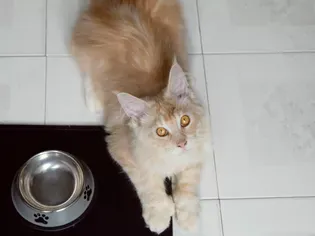How Often Should I Feed My Cat?
Updated on 04/26/24

How Often Should I Feed My Cat? The Ultimate Guide
As a loving cat owner, ensuring your feline companion's optimal health and well-being is paramount. Nutrition plays a crucial role in their overall health, and understanding their feeding frequency is essential. Let's delve into the complexities of cat feeding and establish a tailored feeding schedule that caters to your cat's specific needs.
Determining Feeding Frequency: Age and Activity Level
The frequency of feeding your cat is primarily influenced by their age and activity level. Here's a general breakdown:
- Kittens (under 6 months): Feed 4-6 times daily. Their rapidly growing bodies and high energy levels necessitate frequent meals.
- Young cats (6-12 months): Gradually transition to 3 meals per day. They still need frequent meals, but their growth rate is slowing down.
- Adult cats (1-6 years): Feed 2 meals daily. This is generally sufficient for most healthy adult cats with moderate activity levels.
- Senior cats (6+ years): May need more frequent meals as their metabolism slows down and they become less active. Consider splitting their daily food into 2-3 smaller meals.
Calorie Requirements: Size, Breed, and Health Status
The amount of food you provide your cat should be based on their calorie requirements, which vary depending on their size, breed, and overall health. Consult with your veterinarian to determine the appropriate calorie intake for your cat.
As a general rule, a healthy adult cat weighing around 10 pounds typically requires 250-300 calories per day. However, factors such as breed, activity level, and any underlying health conditions can significantly alter these requirements.
Dry Food vs. Wet Food: Balancing Nutrition
Both dry and wet cat food have their advantages and disadvantages. Dry food is typically preferred for its convenience and ability to promote dental health. Wet food, on the other hand, provides more moisture and is often more palatable for cats.
To ensure a balanced diet, consider feeding your cat a combination of dry and wet food. A good starting point is to offer 75% dry food and 25% wet food daily. Adjust the proportions based on your cat's individual preferences and calorie needs.
Meal Times: Setting a Regular Schedule
Establish regular meal times and stick to them as closely as possible. Cats are creatures of habit and thrive on routine. Feeding them at approximately the same time each day helps regulate their digestive system and prevents them from overeating or underfeeding.
If you work long hours or travel frequently, consider using an automatic cat feeder to ensure your cat is fed on time. However, it's important to monitor your cat's food intake regularly to prevent overfeeding.
Signs of Overfeeding and Underfeeding
Monitoring your cat's body condition is crucial in determining whether they are being overfed or underfed. An overweight cat may have a potbelly, a sagging back, and difficulty grooming. An underweight cat may have sunken eyes, a bony appearance, and reduced energy levels.
If you suspect your cat is overfed or underfed, consult with your veterinarian promptly. They can help you adjust your cat's feeding schedule and diet to achieve an optimal weight and maintain good health.
Feeding Tips for Common Health Conditions
Certain health conditions may necessitate adjustments to your cat's feeding schedule or diet:
- Diabetes: Cats with diabetes require frequent, small meals to help regulate their blood sugar levels.
- Kidney disease: Cats with kidney disease may need a low-protein diet and increased fluid intake.
- Hyperthyroidism: Cats with hyperthyroidism may have an increased appetite and require more frequent meals.
- Dental disease: Cats with dental disease may have difficulty eating dry food. Consider offering them wet food or a softer alternative.
Additional Considerations
- Provide fresh water: Always keep a clean bowl of fresh water available for your cat.
- Avoid table scraps: Table scraps can be high in fat and salt, which can be harmful to cats.
- Monitor treats: Treats should be given sparingly and as part of a balanced diet.
- Transition gradually: When changing your cat's food, transition gradually over 7-10 days to prevent digestive upset.
Conclusion
Determining the optimal feeding frequency for your cat is a multifaceted approach that considers their age, activity level, calorie requirements, and overall health. By understanding these factors and following the guidance provided in this comprehensive guide, you can establish a tailored feeding schedule that promotes your cat's well-being and helps them live a long and healthy life. Remember, consulting with your veterinarian is always advisable when making changes to your cat's diet or feeding habits.
Explore More Pets

Cat Behavior Problems
How to Stop Aggression in Kittens

Long-Haired Cat Breeds
Siberian Cat: Breed Profile, Characteristics, & Care

Cat Behavior Problems
How to Stop Kittens From Scratching and Biting

Long-Haired Cat Breeds
Turkish Angora: Cat Breed Profile, Characteristics & Care

Basic Training
How to Socialize Your Kitten

Short-Haired Cat Breeds
Cute Pictures & Facts About Calico Cats & Kittens

Litter Box Training
Training Your Kitten to Use the Litter Box

Long-Haired Cat Breeds
10 Fun Facts About White Cats